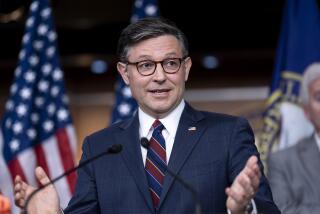Officials Prepare for Government Shutdown : Budget: Agencies rushing to make plans to furlough more than 800,000 workers, including up to 2,000 in O.C. Controversial measure to raise debt ceiling goes to President’s desk.
WASHINGTON — Federal officials Friday began hasty preparations for shutting down most operations on Tuesday in the face of a congressional-White House impasse over legislation to keep the government running.
Agencies prepared to furlough more than 800,000 of the government’s 1.2 million non-military workers, including up to 2,000 in Orange County. Because there was a “real chance” that Congress might not extend borrowing and spending power, Office of Management and Budget Director Alice Rivlin warned agency heads in a memo that “you should begin planning now.”
Meanwhile, the rhetorical heat in Washington rose to a new level after President Clinton publicly urged Congress to work through the weekend, then headed off to play golf on a sunny fall afternoon.
Soon House Speaker Newt Gingrich (R-Ga.) and Senate Majority Leader Bob Dole (R-Kan.) appeared at a press conference, towing golf clubs as props and ridiculing Clinton’s demands.
“We seem to have a President who doesn’t mind playing, doesn’t mind talking, but seems to hate working,” Gingrich said. And, referring to the labors of lawmaking, he added: “This is hard. This isn’t just teeing off.”
Gingrich and Dole later invited Clinton to meet with them today to reopen discussion. Clinton asked White House Chief of Staff Leon E. Panetta to meet with the leaders of both political parties to explore whether a face-to-face conversation with Clinton was warranted, officials said. The Republicans then said that their aides would meet with Panetta--and they would not.
Earlier Friday, the House moved a step closer to a showdown, passing a bill to allow the government to increase its $4.9-trillion borrowing authority by up to $67 billion and sending the measure to the President. Clinton has vowed to veto the bill because it includes a provision that would limit the government’s ability to manage cash flow.
White House officials said they expected to receive the legislation late Friday night, and predicted that the President would execute the veto today.
The House sent a second bill, a stopgap appropriations measure allowing the government to continue spending money after its legal authority to do so runs out at midnight Monday, back to the Senate for final approval. Another vote by the Senate--which is expected Monday--is needed to ratify changes by the House, which stripped out a controversial proposal to limit lobbying by nonprofit groups that receive federal funds.
The prospect of the long-threatened shutdown has increased dramatically in the past several days as it has become clear that the two sides would use these must-pass spending measures for a confrontation over their fundamental differences on the budget. Republicans are insisting that Clinton accept portions of their agenda as part of the measures; the White House maintains that these fiscal measures should not be caught up in the larger dispute.
A shutdown would be triggered if the temporary spending measure, called a continuing resolution, is not signed by Clinton.
If that happens, federal museums will be closed, no visas or passports will be issued and no new applications will be taken for Social Security, veterans’ or other benefits. The Environmental Protection Agency won’t do routine clean water or toxic waste testing--although employees could be pressed into service if a public health threat is anticipated.
Inspections by the Occupational Safety and Health Administration will be suspended. Safety inspections at nuclear weapons plants also would cease, forcing the shutdown of some weapons-assembly lines.
Even top level operations would be affected. Clinton, for example, would have to cut back on the size of the delegation he plans to take to Japan next week for Asian trade talks, officials said.
When employees who are judged nonessential are furloughed, the government would save about $1.04 billion per week in salaries. The furloughed work force includes 99% of the Department of Housing and Urban Development staff, 96% of the EPA, 93% of the Social Security Administration and 78% of the Interior Department.
The Interior Department, which has oversight of the national park system, said in its shutdown plan that park land and wildlife refuges would be closed and public access restricted--if not closed off entirely. But employees at Yosemite National Park said operations at concessions facilities will not be closed.
Federal employees who have to work will do so without pay, hoping that Congress will later appropriate money to cover their salaries. The furloughed workers won’t get any money at all, “and the government is under no obligation to pay them,” one official said.
All of the nation’s active-duty military personnel would continue on normal duties, along with 83% of the reservists and 69% of the Pentagon’s civilian employees.
Social Security, welfare and other benefit checks will be issued on schedule; mail delivery and Amtrak trains will not be interrupted; air traffic controllers, Border Patrol personnel and other federal law enforcement officials will remain on the job. The National Weather Service will continue to offer forecasts and Veterans Administration hospitals will treat patients as usual, officials said.
Money to pay for entitlement benefits is appropriated a full fiscal quarter ahead of time, meaning that beneficiaries don’t have to worry about being cut off unless the shutdown drags on for months--far longer than anyone expects.
The government’s last shutdown was in 1990, when a budget stalemate closed federal offices over the Columbus Day weekend. Many government officials say they believe that this one is likely to last a few days at most, although they allow that it could go on longer in light of the ideological zeal exhibited this week by both sides.
Most government employees in Washington were off on Friday for the Veterans Day holiday, but those who were around contemplated the prospect of unpaid vacation soberly.
*
On Thursday, “people began to realize that this time it’s a definite possibility,” Jim Desler, a Commerce Department spokesman, said as telephones jangled noisily around him.
All federal employees are expected to show up for work Tuesday, when the nonessential workers would be told to close down their operations and head home.
But government bosses have been told not to say too much yet, for fear of upsetting employees unnecessarily. “You don’t want to frighten people without cause,” one official said. “People will say more on Tuesday.”
If there is a shutdown, the largest federal union plans to go to court to try to close down more offices in an effort to pressure the government to reopen the entire bureaucracy. The American Federation of Government Employees would sue “to generate more pressure up front,” said John Sturdivant, the union’s president.
He noted that government employees had been repaid after previous shutdowns. “But given this mean-spirited Congress, there are no guarantees,” he said.
Members of Congress, he pointed out, will continue to draw their pay.
The temporary spending measure, which would extend government spending authority until Dec. 1, is necessary because only two of the 13 appropriations bills needed to keep the government operating in the fiscal year beginning on Oct. 1 have been signed into law. The government is now operating under a stopgap bill--which passed without controversy in September.
*
The House approved the new continuing resolution, 224 to 172, after agreeing to strip out the controversial lobbying provision, which Clinton had opposed. However, lawmakers dropped it not to appease Clinton but because House advocates of the lobbying restrictions objected to the watered-down version put in by the Senate. They decided to drop the matter rather than try to iron out the differences on the continuing resolution.
But the bill still contained provisions unacceptable to Clinton, most notably a part of the GOP plan to save money in Medicare by increasing premiums.
The debt-limit bill was sent to the White House after the House voted, 219 to 185, to accept the version passed by the Senate on Thursday night. That measure had stripped out a proposal to eliminate the Commerce Department, a provision that had been a top priority of House Republican freshmen and other conservatives who had threatened to vote against the debt-limit increase if it did not include that rider. But the freshmen backed down after winning assurances from Senate Republican leaders that the proposal would be tacked onto another measure later this year.
Even with the Commerce Department provision dropped, the debt-limit bill included several riders objectionable to the White House. It would impose new restrictions on the ability of the Treasury Department to dip into the Social Security and other federal trust funds to avert default. Republicans also tacked on legislation to impose new restraints on government regulatory power.
White House officials signaled that there was no chance of negotiation on the measure to increase the borrowing power in its current form.
“That’s automatic veto,” said White House Press Secretary Mike McCurry.
Clinton seized on the GOP efforts to include Medicare fee hikes and general spending cuts in the stopgap spending bill in order to attack its underlying premise.
“Republicans in government have a responsibility to keep the government running without cutting Medicare and increasing premiums, without cutting education and undercutting the environment,” the President said.
Times staff writers Sam Fulwood III, Janet Hook, Colleen Krueger, Jonathan Peterson, James Bornemeier and researcher D’Jamila Salem contributed to this story.
HIGH-WIRE ACT: The budget circus is taking its toll on GOP lawmakers. A24
STATE OF ALERT: Many of California’s 195,000 workers could be idled. A26
BROAD IMPACT: How shutdown, default would hit consumers, investors. D1.
MARKET WORRIES: Stocks, bonds hurt. D1
More to Read
Get the L.A. Times Politics newsletter
Deeply reported insights into legislation, politics and policy from Sacramento, Washington and beyond. In your inbox three times per week.
You may occasionally receive promotional content from the Los Angeles Times.











